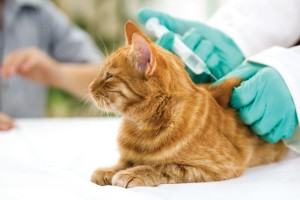Vaccinations and the Health of Your Cat
What exactly are vaccines?
- Vaccines help prepare the body’s immune system to fight the invasion of disease-causing organisms. Vaccines contain antigens, which are partially alive or killed bacteria, viruses, and other foreign substances that don’t cause disease but stimulate the production of antibodies when introduced into the body. Antibodies are the body’s primary immune defense when faced with bacteria, viruses, foreign substances, etc. When the vaccine is introduced to the body, the immune system is mildly stimulated. So if your dog is ever exposed to the real disease and is properly vaccinated, his immune system will be prepared to recognize and fight off the illness or reduce the severity of the illness.
What vaccinations does my cat require?
- The vaccines your cat needs will depend on his/her health status, age, lifestyle, and what diseases are common in your area. A rabies vaccination is required by law to protect both animals and people.
- We will evaluate your cat’s individual needs in order to discuss which vaccines are necessary and how often they should be given to provide the best protection for your cat.
Why does my cat need to be vaccinated?
- Vaccines help to protect against specific infectious diseases caused by some viruses and bacteria. They stimulate the body’s immune system to destroy the organism and recognize it so that it can fight against the infection again if necessary in the future. Without vaccination, many cats become seriously ill or may even die from diseases that their immune system is unable to fight effectively on its own. The use of vaccines has prevented death and disease in millions of cats. In addition, vaccines protect people from disease, such as rabies, that could be transmitted from cats.
- It is important to remember that even cats living totally indoors require regular Rabies vaccinations as they may be exposed to diseases (such by travel or boarding, interaction with other cats, the addition of a new cat to the home, and viruses carried on your clothing or in the air). Bats are an especially significant carrier of Rabies that your indoor cat can be easily exposed to by getting into your home.
- Some diseases are easier to vaccinate against than others. For example, vaccination is very effective against panleukopenia, but does not completely protect against respiratory virus infections. However, cats vaccinated against respiratory tract infections generally have milder illness than if they hadn’t been vaccinated, and are far less likely to become severely affected or to die from the disease.
Why does my kitten need a series of more than one vaccine?
- Newborn kittens depend on their mothers not just for food and warmth, but also for protection against infectious diseases. The first few times they nurse, kittens get antibodies from their mother’s milk that will help to keep them safe for a few weeks to several months. This immunity provided by “maternally derived antibodies” (MDA) are protective for kittens while their own immune system is immature. However, when the anti-body levels decrease before the kitten has developed his/her own immunity, gaps in protection will occur, leaving the kitten susceptible to disease. Also while the kitten has high levels of MDA, their immune system will not respond optimally to vaccination. Since we cannot predict for each kitten when MDA has decreased adequately to allow an effective response to vaccination, guidelines have been developed to protect as many kittens as possible against disease by giving a series of vaccinations. An incomplete series of kitten vaccinations may leave your kitten vulnerable to infection, so it is important to follow your veterinarian’s recommendations and vaccinate up to at least 16 weeks of age. (Vaccine Guidelines 2013 AAFP).
How often does my cat need to be re-vaccinated?
- Many things need to be taken into consideration when deciding how often your cat needs to be vaccinated. These include such things as:
- Health status
- Age and lifestyle of the cat
- How long a specific vaccine provides protection for (“duration of immunity”)
- How likely the cat is to be exposed to the infectious agent
- How dangerous this agent might be
- Licensing regulations in each state
Can we skip annual vaccines and just get titer tests done? We advocate for regular vaccination. Please visit for more information https://www.aaha.org/aaha-guidelines/2022-aaha-canine-vaccination-guidelines/utilization-and-interpretation-of-serologic-titers/
What are the risks of vaccinations?
- The benefits of vaccination greatly outweigh possible risks. Just as in children, following vaccination your cat may experience mild and short-lived reactions (malaise), such as poor appetite, lethargy, and fever that resolve without treatment. Any symptoms that persist for more than a day or two should be discussed with your veterinarian.
- Rarely, more serious allergic reactions occur and may include vomiting, diarrhea, facial swelling, or difficulty breathing. These serious reactions appear within minutes or hours of vaccination, and require immediate veterinary care.
The FVRCP vaccination protects your cat against three contagious diseases. Kittens receive four FVRCP injections, starting at the age of six to eight weeks. A booster shot is typically given annually, or every three years depending on the cat’s age.
- FVR = Feline Viral Rhinotracheitis. This is a severe upper respiratory infection that is most dangerous to young kittens and older cats. The virus is extremely contagious to cats, and is caused by a feline herpes virus. FVR can leave some cats with permanent respiratory system and optical damage.
- C = Calcivirus. There are several different strains of calcivirus, causing a range of illness from mild infection to life-threatening pneumonia. The more dangerous strains can be deadly to young kittens and older cats. Calcivirus is transmitted through direct contact with an infected cat or an infected item.
- P = Panleukopenia, also known as feline distemper. Feline distemper is a highly contagious disease that moves very quickly through the system. It is caused by a parvovirus similar to the parvovirus seen in dogs. As many as 90% of young kittens (under six months old) with panleukopenia do not survive the virus. The disease is most severe in young kittens but can affect cats of all ages. Panleukopenia may remain active in the environment for up to a year without a host.
Feline Leukemia
Contrary to what its name implies, feline leukemia (abbreviated FeLV or sometimes referred to as “feleuk”) is not a blood cancer – although it can cause cancer affecting the blood. Instead, it is a viral infection that can set up shop anywhere in a cat’s body. Once a cat contracts the virus, it cannot be cured, but keeping a cat current on his vaccinations will prevent disease associated with FeLV. Though it is not a core vaccine, it is recommended for cats at risk for exposure to this disease, such as cats that are allowed outdoors or cats that occasionally escape from indoors.
Feline leukemia virus is moderately contagious, generally transmitted when a cat comes into contact with saliva from an infected cat (via social behaviors, such as mutual grooming and sharing food and water bowls). Mother-to-kitten transmission can occur in-utero as well.
Since FeLV can affect almost any organ system in the body, clinical signs can vary significantly. In fact, some cats seem perfectly healthy, but retain the ability to transmit the disease to others; this cat would be considered a carrier and a potential risk for other FeLV-cats.
Though it’s considered a non-core vaccine, this vaccine is highly recommended by the Association of Feline Practitioners for all cats up to 2 years of age. Ideally, cats should be tested for FeLV infection before their initial vaccination and when there is a possibility that they have been exposed to FeLV since they were last vaccinated. Only FeLV negative cats should be vaccinated for FeLV.
Office HoursMonday: 8:00 am to 5:00 pm Tuesday: 8:00 am to 7:00 pm Wednesday: 8:00am to 5:00pm Thursday: 8:00 am to 7:00 pm Friday: 8:00 am to 5:00 pm Saturday: Closed Sunday: Closed In the event of a medical emergency outside our normal business hours please visit: Contact Us-Emergency Information |
|
Site powered by Weebly. Managed by IDEXX Laboratories






